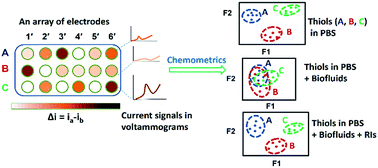Combining cross-reactivity of an electrode array with the selective thiol reporting process of redox indicators: targeted sensing of biothiols†
Abstract
This paper describes the syntheses, characterization, and electro-analytical applications of metallophthalocyanine and metallophthalocyanine embedded GO/rGO materials, named CuPc (1), MnPc (2), GO–CuPc–PDA (3), GO–MnPc–PDA (4), rGO–CuPc–PDA (5), and rGO–MnPc–PDA (6) (where CuPc = copper phthalocyanine, MnPc = manganese phthalocyanine, GO = graphene oxide, rGO = reduced graphene oxide, and PDA = polydopamine). The synthesized materials were dip coated over a glassy carbon electrode (GCE) surface to yield an array of six electrodes (1′–6′). Each of the electrodes has shown distinct voltammetric oxidation signals towards different biothiols, such as cysteine (Cys), glutathione (GSH), and homocysteine (Hcys). The collective response of the electrode array was analyzed using chemometric analysis, such as linear discriminant analysis (LDA), which enables the simultaneous detection of Cys, GSH, and Hcys in a phosphate buffer. However, the application of the electrode array technique to the biomarker detection is often complicated due to the non-specific interference of protein components present in biofluids. We demonstrate a proof-of-principle that such interference in discriminatory sensing of thiols can be circumvented via combining the cross-reactivity of the electrode array with the selective thiol reporting process of redox indicators (RIs), such as ascorbic acid (AA), dopamine (DA), and uric acid (UA).



 Please wait while we load your content...
Please wait while we load your content...